Tricholoma sulphureum (Bull.) P. Kumm. - Sulphur Knight
Phylum: Basidiomycota - Class: Agaricomycetes - Order: Agaricales - Family: Tricholomataceae
Distribution - Taxonomic History - Etymology - Identification - Culinary Notes - Reference Sources
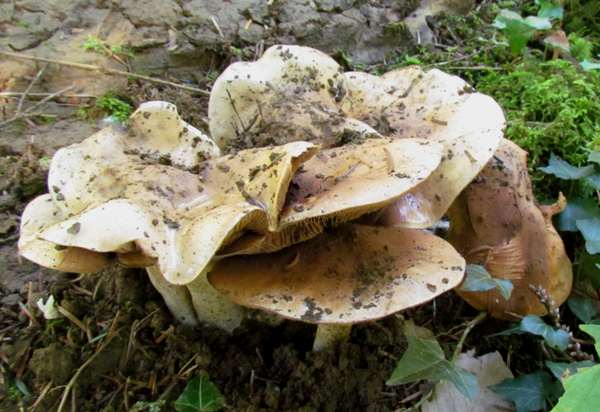
An occasional find, Tricholoma sulphureum, the Sulphur Knight, used to be referred to as the Gas Works Mushroom because of its strong pungent odour. This inedible mushroom is sometimes found under willows on damp land, but more often it is mycorrhizal with Beech and oaks.
Surprisingly, despite its extremely pungent odour, this mushroom does not have a distinctive taste. It is, however, known to be poisonous and so the repulsive smell may be something of a blessing.
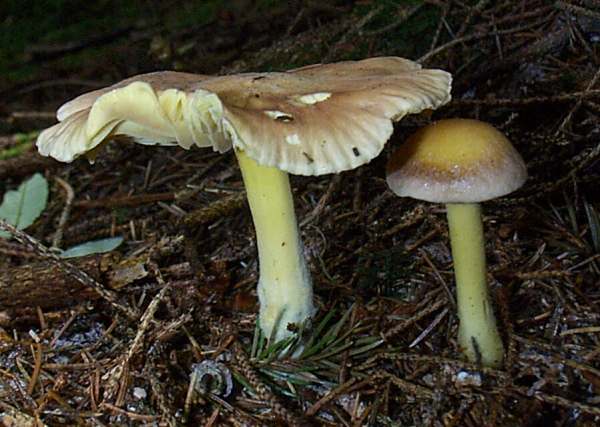
Although most often these stinkers are very east to spot not only because of their smell but also because of their bright yellow caps, they have a habit of hiding beneath leaf litter. Some specimens, like the pair shown below, are well camouflaged because their caps have purplish tinges and could easily be mistaken for the rare (in Britain) Tricholoma bufonium (Pers.) Gillet, whose cap is a striking light purple colour. Many authorities including Comandini et al (see references, below) have concluded that Tricholoma bufonium is merely an infraspecific variant of Tricholoma sulphureum.
Distribution
This mycorrhizal woodland mushroom is fairly common and widespread throughout Britain and Ireland, and it occurs in most parts of mainland Europe. Tricholoma sulphureum is also recorded in North America
Taxonomic history
Although this mushroom was described scientifically in 1784 by French mycologist Jean Baptiste Francois (Pierre) Bulliard, who named it Agaricus suphureus (at a time when most gilled fungi were initially placed in a gigantic agaricus genus, now largely redistributed across many other new genera), its currently-accepted binomial name Tricholoma sulphureum did not come into existence until 1871, when German mycologist Paul Kummer transferred this species to its present genus.
Tricholoma sulphureum has a number of synonyms including Agaricus sulphureus Bull., Gymnopus sulphureus (Bull.) Gray, and Tricholoma sulphureum (Bull.) P. Kumm.
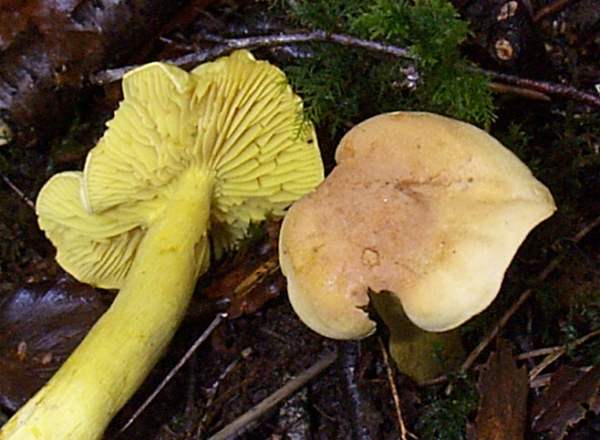
Two very rare varieties of the Sulphur Knight are found, mainly in southern Europe. They are Tricholoma sulphureum var. hemisulphureum Kühner, which is also known by its common synonym Tricholoma hemisulphureum (Kühner) A. Riva; and Tricholoma sulphureum var. pallidum Bon. The autonomous form is therefore referred to formally as Tricholoma sulphureum var. sulphureum (Bull.) P. Kumm.
Etymology
Tricholoma was established as a mushroom genus by the great Swedish mycologist Elias Magnus Fries. The generic name Tricholoma comes from Greek words meaning 'hairy fringe', and it must be one of the least appropriate mycological genus names, because very few species within this genus have hairy or even shaggily scaly cap margins that would justify the descriptive term.
The specific epithet sulphureum is a reference to the colour (sulphur yellow) of these mushrooms and is quite appropriate for their odour, too, which is similar to that of coal gas. Coal contains small amounts of sulphur, and so foul-smelling sulphur dioxide is produced when it burns. (In the USA the spelling 'sulfur' is used, but sulfur dioxide smells just as ghastly as sulphur dioxide!)
Identification guide
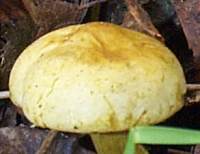 |
CapSulphur yellow, often with reddish-brown or olive tints; convex, usually with a wavy margin, sometimes flattening or becoming slightly depressed, but retaining an umbo; matt; 3 to 8cm across. |
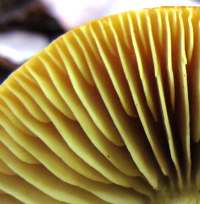 |
GillsBright sulphur yellow; broad; distant; sinuate (notched near the stem). StemYellow, lined vertically with sparse reddish fibres; cylindrical; 3 to 5cm long, 0.6 to 1cm dia.; no ring. |
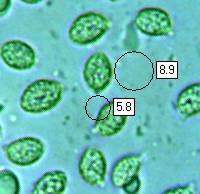 |
SporesEllipsoidal, smooth, with a pronounced attachment peg (known as a hilar appendage); 9-12 x 5-6.5μm; inamyloid. Spore printWhite. |
Odour/taste |
Very strong odour of coal gas - so strong that you won't want to have it near enough to do a nibble test! |
Habitat & Ecological role |
Ectomycorrhizal with deciduous broadleaf trees - mainly oaks and Beech - and just occasionally found also in coniferous woodland. |
Season |
Although the main fruiting season is late summer and autumn, Sulphur Knights can appear in Britain and Ireland as early as the end of springtime. |
Similar species |
Tricholoma equestre, mainly a northern species in Britain, has a yellow cap with a brown-olive central area; it has no significant odour. |
Culinary Notes
The Sulphur Knight is known to be poisonous, and so its repulsive odour may be something of a blessing as it would deter all but those who have lost their sense of smell.
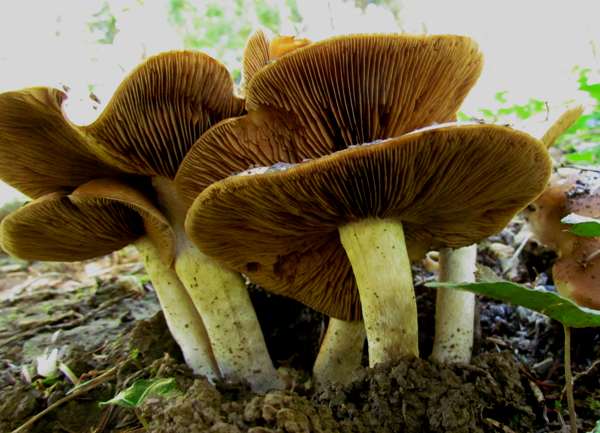
Reference Sources
Fascinated by Fungi, 2nd Edition, Pat O'Reilly 2016, reprinted by Coch-y-bonddu Books in 2022.
Kibby, G (2013) The Genus Tricholoma in Britain, published by Geoffrey Kibby
Uniting Tricholoma sulphureum and T. bufonium. Comandini O, Haug I, Rinaldi AC, Kuyper TW; Mycological Research. 2004 Oct; 108 (Pt 10): 1162-71.
Dictionary of the Fungi; Paul M. Kirk, Paul F. Cannon, David W. Minter and J. A. Stalpers; CABI, 2008
Taxonomic history and synonym information on these pages is drawn from many sources but in particular from the British Mycological Society's GB Checklist of Fungi.
Fascinated by Fungi. Back by popular demand, Pat O'Reilly's best-selling 450-page hardback book is available now. The latest second edition was republished with a sparkling new cover design in September 2022 by Coch-y-Bonddu Books. Full details and copies are available from the publisher's online bookshop...

